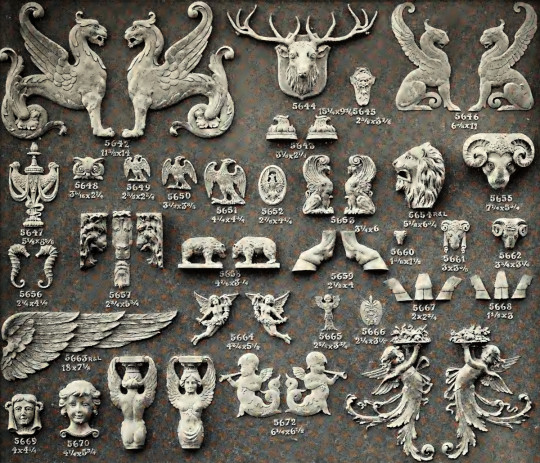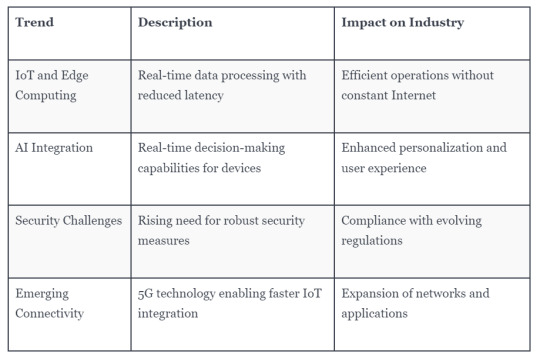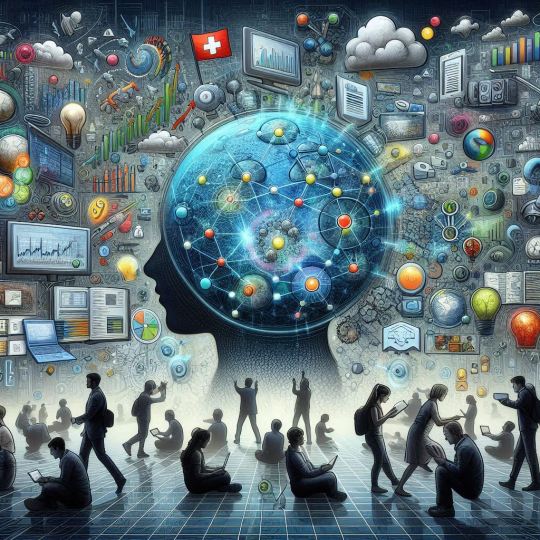#IoT architecture
Explore tagged Tumblr posts
Text
#IoT architecture#IoT architecture layers#IoT layers#Edge computing in IoT#IoT data processing#IoT security#Legacy IoT
0 notes
Text
Frontend Architecture And How To Improve Its Design
The creation of web-based applications isn't an easy task. You must develop an effective front-end architecture to design feature-rich software. However, there is only a little information about the latest frontend technology that is interesting for professionals. In the majority of cases, you can find such details in the technical literature. If there was an instructional guide to explain the micro-front-end architecture in simple phrases!. If you're looking for this kind of information that isn't stuffed with technical terms, this blog will be beneficial. It provides the essential elements developers must think about when creating the front-end architecture of their software development projects. Therefore, you should read the article until the end.
Visit us:
0 notes
Text
#iot#what is iot#iot projects#iot tutorial#iot training#iot applications#iot explained#iot basics#introduction to iot#iot technology#learn iot#iot course#iot internet of things#iot tutorial for beginners#simplilearn iot#iot devices#iot architecture#iot certification#how iot works#iot 2022#what is iot technology#iot full course#understanding iot#iot edureka#iot project#internet of things (iot)#ai + iot#why iot#secretstime#newblogflo
0 notes
Text
Quinque gazump linkdump

On OCTOBER 23 at 7PM, I'll be in DECATUR, presenting my novel THE BEZZLE at EAGLE EYE BOOKS.

It's Saturday and any fule kno that this is the day for a linkdump, in which the links that couldn't be squeezed into the week's newsletter editions get their own showcase. Here's the previous 23 linkdumps:
https://pluralistic.net/tag/linkdump/
Start your weekend with some child's play! Ada & Zangemann is a picture book by Matthias Kirschner and Sandra Brandstätter of Free Software Foundation Europe, telling the story of a greedy inventor who ensnares a town with his proprietary, remote-brickable gadgets, and Ada, his nemesis, a young girl who reverse engineers them and lets their users seize the means of computation:
https://fsfe.org/activities/ada-zangemann/index.en.html
Ada & Zangemann is open access – you can share it, adapt it, and sell it as you see fit – and has been translated into several languages. Now, there's a cartoon version, an animated adaptation that is likewise open access, with digital assets for your remixing pleasure:
https://fsfe.org/activities/ada-zangemann//movie
Figuring out how to talk to kids about important subjects is a clarifying exercise. Back in the glory days of SNL, Eddie Murphy lampooned Fred "Mr" Rogers style of talking to kids, and it was indeed very funny:
https://snl.fandom.com/wiki/Mr._Robinson
But Mr Rogers' rhetorical style wasn't as simple as "talk slowly and use small words" – the "Fredish" dialect that Mr Rogers created was thoughtful, empathic, inclusive, and very effective:
https://memex.craphound.com/2019/07/09/the-nine-rules-of-freddish-the-positive-inclusive-empathic-language-of-mr-rogers/
Lots of writers have used the sing-songy fairytale style of children's stories to make serious political points (see, e.g. Animal Farm). My own attempt at this was my 2011 short story "The Brave Little Toaster," for MIT Tech Review's annual sf series. If the title sounds familiar, that's because I nicked it from Tom Disch's tale of the same name, as part of my series of stolen title stories:
https://locusmag.com/2012/05/cory-doctorow-a-prose-by-any-other-name/
My Toaster story is a tale of IoT gone wild, in which the nightmare of a world of "smart" devices that exert control over their owners is shown to be a nightmare. A work colleague sent me this adaptation of the story as part of an English textbook, with lots of worksheet-style exercises. I'd never seen this before, and it's very fun:
http://ourenglishclass.net/wp-content/uploads/sites/6/2024/09/bravetoaster.pdf
If you like my "Brave Little Toaster," you'll likely enjoy my novella "Unauthorized Bread," which appears in my 2019 collection Radicalized and is currently being adapted as a middle-grades graphic novel by Blue Delliquanti for Firstsecond:
https://arstechnica.com/gaming/2020/01/unauthorized-bread-a-near-future-tale-of-refugees-and-sinister-iot-appliances/
Childlike parables have their place, but just because something fits in a "just so" story, that doesn't make it true. Cryptocurrency weirdos desperately need to learn this lesson. The foundation of cryptocurrency is a fairytale about the origin of money, a mythological marketplace in which freely trading individuals who struggled to find a "confluence of needs." If you wanted to trade one third of your cow for two and a half of my chickens, how could we complete the transaction?
In the "money story" fairy tale, we spontaneously decided that we would use gold, for a bunch of nonsensical reasons that don't bear even cursory scrutiny. And so coin money sprang into existence, and we all merrily traded our gold with one another until a wicked government came and stole our gold with (cue scary voice) taaaaaaxes.
There is zero evidence for this. It's literally a fairy tale. There is a rich history of where money came from, and the answer, in short is, governments created it through taxes, and money doesn't exist without taxation:
https://locusmag.com/2022/09/cory-doctorow-moneylike/
The money story is a lie, and it's a consequential one. The belief that money arises spontaneously out of the needs of freely trading people who voluntarily accept an arbitrary token as a store of value, unit of account, and unit of exchange (coupled with a childish, reactionary aversion to taxation) inspired cryptocurrency, and with it, the scams that allowed unscrupulous huxters to steal billions from everyday people who trusted Matt Damon, Spike Lee and Larry David when they told them that cryptocurrency was a sure path to financial security:
https://pluralistic.net/2024/02/15/your-new-first-name/#that-dagger-tho
It turns out that private money, far from being a tool of liberation, is rather just a dismal tool for ripping off the unsuspecting, and that goes double for crypto, where complexity can be weaponized by swindlers:
https://pluralistic.net/2022/03/13/the-byzantine-premium/
We don't hear nearly as much about crypto these days – many of the pump-and-dump set have moved on to pitching AI stock – but there's still billions tied up in the scam, and new shitcoins are still being minted at speed. The FBI actually created a sting operation to expose the dirtiness of the crypto "ecosystem":
https://www.theverge.com/2024/10/10/24267098/fbi-coin-crypto-token-nexgenai-sec-doj-fraud-investigation
They found that the exchanges, "market makers" and other seemingly rock-ribbed institutions where suckers are enticed to buy, sell, track and price cryptos are classic Big Store cons:
http://www.amyreading.com/the-9-stages-of-the-big-con.html
When you, the unsuspecting retail investor, enter one of these mirror-palaces, you are the only audience member in a play that everyone else is in on. Those vigorous trades that see the shitcoin you're being hustled with skyrocketing in value? They're "wash trades," where insiders buy and sell the same asset to one another, without real money ever changing hands, just to create the appearance of a rapidly appreciating asset that you had best get in on before you are priced out of the market.
This scam is as old as con games themselves and, as with other scams- S&Ls, Enron, subprime – the con artists have parlayed their winnings into social respectability and are now flushing them into the political system, to punish lawmakers who threaten their ability to rip off you and your neighbors. A massive, terrifying investigative story in The New Yorker shows how crypto billionaires stole the Democratic nomination from Katie Porter, one of the most effective anti-scam lawmakers in recent history:
https://www.newyorker.com/magazine/2024/10/14/silicon-valley-the-new-lobbying-monster
Big Tech – like every corrupt cartel in history – is desperate to conjure a kleptocracy into existence, whose officials they can corrupt in order to keep the machine going until they've maximized their gains and achieved escape velocity from consequences.
No surprise, then, that tech companies have adopted the same spin tactics that sowed doubt about the tobacco-cancer link, in order to keep the US from updating its anemic privacy laws. The last time Congress gave us a new consumer privacy law was 1988, when they banned video store clerks from disclosing our VHS rental history to newspapers:
https://en.wikipedia.org/wiki/Video_Privacy_Protection_Act
By preventing confining privacy law to the VCR era, Big Tech has been able to plunder our data with impunity – aided by cops and spies who love the fact that there's a source of cheap, off-the-books, warrantless surveillance data that would be illegal for them to collect.
Writing for Tech Policy Press, the Norcal ACLU's Jake Snow connects the tobacco industry fight over "pre-emption" to the modern fight over privacy laws:
https://www.techpolicy.press/big-tech-is-trying-to-burn-privacy-to-the-ground-and-theyre-using-big-tobaccos-strategy-to-do-it/
In the 1990s, Big Tobacco went to war against state anti-smoking laws, arguing that the federal government had the right – nay, the duty – to create a "harmonized" national system of smoking laws that would preempt state laws. Strangely, politicians who love "states' rights" when it comes to banning abortion, tax-base erosion and "right to work" anti-union laws suddenly discovered federal religion when their campaign donors from the Cancer-Industrial Complex decided that states shouldn't use those rights to limit smoking.
This is exactly the tack that Big Tech has taken on privacy, arguing that any update to federal privacy law should abolish muscular state-level laws, like Illinois's best-in-class biometric privacy rules, or California's CPPA.
Like Big Tobacco, Big Tech has "funded front groups, hired an armada of lobbyists, donated millions to campaigns, and opened a firehose of lobbying money," with the goal of replacing "real privacy laws with fake industry alternatives as ineffective as non-smoking sections."
Whether it's understanding the origin of money or the Big Tobacco playbook, knowing history can protect you from all kinds of predatory behavior. But history isn't merely a sword and shield, it's also just a delight. Internet pioneer Ethan Zuckerman is road-tripping around America, and in August, he got to Columbus, IN, home to some of the country's most beautiful and important architectural treasures:
https://ethanzuckerman.com/2024/08/29/road-trip-the-company-town-and-the-corn-fields/
The buildings – clustered in within a few, walkable blocks – are the legacy of the diesel engine manufacturing titan Cummins, whose postwar president J Irwin Miller used the company's wartime profits to commission a string of gorgeous structures from starchitects like the Saarinens, IM Pei, Kevin Roche, Richard Meier, Harry Weese, César Pelli, Gunnar Birkerts, and Skidmore. I had no idea about any of this, and now I want to visit Columbus!
I'm planning a book tour right now (for my next novel, Picks and Shovels, which is out in February) and there's a little wiggle-room in the midwestern part of the tour. There's a possibility that I'll end up in the vicinity, and if that happens, I'm definitely gonna find time for a little detour!

Tor Books as just published two new, free LITTLE BROTHER stories: VIGILANT, about creepy surveillance in distance education; and SPILL, about oil pipelines and indigenous landback.


If you'd like an essay-formatted version of this post to read or share, here's a link to it on pluralistic.net, my surveillance-free, ad-free, tracker-free blog:
#pluralistic#linkdump#linkdumps#iot#internet of shit#brave little toaster#drm#copyfight#fsfe#big tobacco#denialism#Ada and Zangemann#Matthias Kirschner#ethan zuckerman#columbus#ohio#road trips#architecture#fbi#sting operations#pump and dump#scams#crypto#cryptocurrency#wash trading#ethereum
49 notes
·
View notes
Text
I'm reading about subject headings and analysis and the organization thereof and was like, why the FUCK am I getting force-fed shitty automated subject analysis that demonstrably wrecks search accuracy when the tech industry could be building me the foundations for an AR linked data schema that I can physically manipulate in space. A thing I have been asking for (aka fantasizing about and then writing into discarded pieces of fiction) for years. This has been my dream since I saw fucking Iron-Man in like 2009. And we have the technology! We have plenty of AR and VR tech that would probably be more viable on a commercial scale than the consumer scale they tried to design it to be! What the fuck!
#taking a sharp left turn to do research in information architecture specifically to force this through#no no I can't make that kind of joke cuz I will fucking try to do it#absolutely fucking unbelievable that the tech industry is trying to build consumer IoT spyware instead of this#I'm going to kill#megs vs mlis
11 notes
·
View notes
Text

#white monster#twink#femboys#prius c#art#art of tumblr#black trans lives matter#mexican#mental illness#digital art#my little pony#architecture#aftg#iot#vr#artwork#my art#artists on tumblr#nail art#cat#punk rock#cats#emo#alt rock#soundcloud#spotify
3 notes
·
View notes
Text

openBIM® by Sonetra KETH
openBIM® is a collaborative approach and an ecosystem of open standards, protocols, and workflows that enable interoperability across different BIM software platforms, stakeholders, and disciplines in the Architecture, Engineering, and Construction (AEC) industry.
openBIM® represents an industry-wide movement towards interoperability and open standards that facilitate collaborative, data-rich BIM workflows across diverse software platforms and stakeholders, ultimately fostering a more integrated, flexible, and sustainable built environment ecosystem.
Core Principles of openBIM®
Interoperability: Seamless exchange of BIM data without proprietary restrictions.
Open Standards: Relying on internationally recognized, non-proprietary standards to facilitate data consistency and collaboration.
Open Data Exchange: Promoting a data-centric approach where model information can be shared, interpreted, and used across various tools.
Collaborative Ecosystem: Enabling multiple stakeholders using different applications to work collectively on a project.
Key Components of openBIM®
Standards and Protocols
Industry Foundation Classes (IFC): The core openBIM schema developed by buildingSMART® for rich, schema-based exchange of geometric and semantic data.
bSDD (buildingSMART Data Dictionary): A comprehensive repository of standardized data definitions to ensure semantic consistency.
CityGML, IFC-SPF: Additional standards for GIS, infrastructure, and other data formats.
IFC, BCF (BIM Collaboration Format): For model data exchange and issue tracking.
Tools and Software
Various BIM applications supporting openBIM standards, enabling import/export, viewing, validation, and collaboration while maintaining data integrity.
The interoperability is made possible through software certifications and compatibility testing, often coordinated by buildingSMART®.
Workflow & Data Management
Emphasizes a model-centric approach, where the central repository is an IFC model that can be accessed, modified, and referenced by multiple applications.
Promotes open data exchange rather than proprietary formats, reducing vendor lock-in and fostering innovation.
Advantages of openBIM®
Vendor Neutrality: No single vendor controls the data exchange standards.
Flexibility & Compatibility: Enables collaboration across various platforms (Revit, ArchiCAD, Vectorworks, Tekla, etc.).
Long-term Data Sustainability: Ensures that project data remains usable and understandable over time.
Enhanced Collaboration: Stakeholders can work concurrently, review, issue comments, and coordinate effectively.
RMIT University Vietnam (2015)
youtube
buildingSMART International Technical Director Léon van Berlo who discusses the openBIM workflow
Sonetra KETH (កេត សុនេត្រា) •Architectural Manager, Project Manager, BIM Director •建築師經理, 專案經理, BIM總監 •Giám đốc kiến trúc, Giám đốc dựán, Giám đốc BIM •RMIT University Vietnam + Institute of Technology of Cambodia
#Sonetra Keth#Architectural Manager#Architectural Design Manager#BIM Director#BIM Manager#BIM Coordinator#Project Manager#RMIT University Vietnam#Real Estate Development#Construction Industry#Building Information Modelling#BIM#AI#Artificial Intelligence#6th Annual BIM Summit#Technology#VDC#Virtual Design#IoT#Khmer BIM#Machine Learning#C4R#Collaboration for Revit#NETRA#netra#នេត្រា#កេត សុនេត្រា#crossorigin=“anonymous”></script>#<meta name=“google-adsense-account” content=“ca-pub-9430617320114361”>#<script async src=“https://pagead2.googlesyndication.com/pagead/js/adsbygoogle.js?client=ca-pub-9430617320114361”
0 notes
Text

Typical Detail: RC Slab Drop Panel 典型细节: 钢筋混凝土板 Drop Panel by Sonetra KETH
Drop panels are reinforced concrete extensions around the top of shear walls, columns, or heavily loaded areas. They are critical elements in seismic and load-resistant structural design. Slab drop panels are thickened areas around columns in flat slab construction, increasing shear strength and enabling the slab to support greater loads. This feature is typical of flat slab systems, which are two-way reinforced structures.
Drop Panels are needed because:
Shear and Moment Resistance: They enhance the capacity of vertical structural elements (shear walls or columns) to resist bending moments and shear forces, especially at the critical junctions (e.g., wall-column interfaces).
Reduce Stress Concentrations: Drop panels distribute concentrated shear and axial loads more evenly into the foundation or diaphragm, preventing stress concentrations and potential structural failure.
Increase Structural Rigidity and Stability: They improve the overall stiffness and robustness where high load or seismic forces are expected, especially in high-rise or seismic zones.

Typical Detail: Column-Slab Section Views
典型细节: 钢筋混凝土柱和板 剖面图 by Sonetra KETH
Much engineering judgment is required to reach a sound conclusion on the allowable movements that can be safely tolerated in a tall building. Several factors need to be taken into account. These are:
Type of framing employed for the building
Magnitude of total as well as differential movement
The rate at which the predicted movement takes place
Type of movement, whether the deformation of the soil causes tilting or vertical displacement of the building
Every city has its own particular characteristics regarding the design and construction of foundations for tall buildings, which are characterized by the local geology and groundwater conditions. Their choice for a particular project is primarily influenced by economic and soil conditions, and even under identical conditions, it can vary in different geographical locations. In this section, a brief description of two types, namely, the pile and mat foundations, is given, highlighting their practical aspects.
Sonetra KETH (កេត សុនេត្រា) Architectural Manager/Project Manager/BIM Director RMIT University Vietnam + Institute of Technology of Cambodia
#Sonetra Keth#Architectural Manager#Architectural Design Manager#BIM Director#BIM Manager#BIM Coordinator#Project Manager#RMIT University Vietnam#Real Estate Development#Construction Industry#Building Information Modelling#BIM#AI#Artificial Intelligence#6th Annual BIM Summit#Technology#VDC#Virtual Design#IoT#Khmer BIM#Machine Learning#C4R#Collaboration for Revit#NETRA#netra#នេត្រា#កេត សុនេត្រា#crossorigin=“anonymous”></script>#<meta name=“google-adsense-account” content=“ca-pub-9430617320114361”>#<script async src=“https://pagead2.googlesyndication.com/pagead/js/adsbygoogle.js?client=ca-pub-9430617320114361”
0 notes
Text
AI vs Human Intelligence: Who's Winning and Where Are the Limits
AI has made stunning leaps: language models, self-driving cars, drug discovery. But human intelligence remains the gold standard for creativity, emotional understanding, and adaptability. What is Human Intelligence? Natural ability of human to think, learn, understands emotions, solve problems, reasoning and adapt to new situation, creativity and intuition What is Artificial…

View On WordPress
0 notes
Text
#Retail Inventory Management#Microservices Architecture#Event-Driven Architecture#AI in Retail#IoT Integration#Blockchain Transparency#Real-Time Data Processing#Supply Chain Optimization#Retail Technology#Inventory Optimization
0 notes
Text
Big Data and the Internet of Things (IoT): The Power of Analytics
In today’s hyperconnected world, the intersection of the Internet of Things (IoT) and Big Data analytics is reshaping industries, providing businesses with unprecedented insights, and fueling a new wave of innovation. The vast amount of data generated by IoT devices offers immense opportunities to derive actionable insights. By leveraging IoT Big Data solutions, companies can optimize processes, enhance customer experiences, and drive business growth.

This article explores how IoT Big Data analytics, IoT Big Data architecture, and machine learning are transforming industries and providing valuable solutions.
The Explosion of IoT Data
The Internet of Things refers to the network of physical devices connected to the internet, gathering and sharing data. These devices include everything from smart home appliances and wearable health monitors to industrial sensors and autonomous vehicles. According to Statista, the number of IoT-connected devices is projected to reach 30.9 billion by 2025, generating a massive amount of data.
This data deluge presents significant challenges but also immense opportunities for organizations. By implementing IoT Big Data solutions, companies can collect, store, analyze, and act on this vast amount of information to improve decision-making, efficiency, and innovation.
IoT Big Data Analytics: Turning Data Into Insights
One of the most significant advantages of combining IoT with Big Data analytics is the ability to transform raw data into actionable insights. IoT Big Data analytics involves analyzing large volumes of data generated by IoT devices to identify patterns, trends, and anomalies that can inform business decisions.
Real-World Application: In the automotive industry, companies like Tesla use IoT sensors embedded in vehicles to monitor real-time data related to performance, maintenance needs, and driving patterns. This data is then processed through Big Data analytics to improve vehicle performance, anticipate maintenance issues, and even enhance autonomous driving features. Tesla’s ability to leverage IoT Big Data is a key factor in its innovative approach to automotive technology.
Moreover, GE Aviation uses IoT sensors in aircraft engines to monitor real-time performance data. By leveraging Big Data analytics, GE predicts engine failures and schedules proactive maintenance, improving safety and reducing downtime.
IoT Big Data Architecture: The Backbone of Data Processing
To efficiently process and analyze data from millions of IoT devices, businesses need a scalable and robust IoT Big Data architecture. This architecture typically includes:
Data Collection Layer: Sensors and devices collect and transmit data.
Data Ingestion Layer: Middleware solutions or platforms like Apache Kafka are used to ingest data in real-time, handling the large influx of information from various IoT sources.
Data Storage Layer: Data is stored in cloud-based or on-premise databases. Solutions like AWS IoT or Azure IoT are popular choices for storing and managing vast amounts of IoT data.
Data Processing and Analytics Layer: Advanced analytics platforms, such as Hadoop or Apache Spark, process large datasets to extract insights.
Visualization Layer: Insights are presented through dashboards or visualization tools, allowing stakeholders to make informed decisions.
This architecture supports the seamless flow of data from collection to actionable insights, enabling organizations to scale their IoT initiatives.
IoT and Machine Learning: Driving Smarter Solutions
The integration of machine learning with IoT Big Data creates smarter, more predictive systems. Machine learning models analyze the vast datasets generated by IoT devices to detect patterns, learn from them, and predict future outcomes. This combination unlocks powerful IoT Big Data solutions for industries ranging from healthcare to manufacturing.
Practical Example: In healthcare, IoT medical devices such as wearable fitness trackers and smart medical sensors monitor patients’ vitals, including heart rate, blood pressure, and oxygen levels. By feeding this data into machine learning models, healthcare providers can predict potential health risks and intervene early. For instance, machine learning algorithms can detect irregular heart patterns in real-time and alert doctors before a critical event occurs, ultimately saving lives.
In manufacturing, IoT sensors on equipment monitor real-time performance and detect potential failures. By integrating machine learning, manufacturers can predict when machinery is likely to fail and schedule maintenance ahead of time. This proactive approach reduces downtime and increases efficiency.
IoT Big Data Solutions: Real-World Impact
Industries are already reaping the benefits of IoT Big Data solutions, transforming how they operate and deliver value to customers.
Smart Cities: Cities like Barcelona and Singapore have deployed IoT sensors to monitor traffic patterns, optimize waste management, and manage energy consumption. With Big Data analytics, city administrators can improve urban planning and enhance the quality of life for residents. Smart traffic systems use IoT data to reduce congestion, while smart lighting systems adjust brightness based on real-time data to conserve energy.
Retail: IoT sensors in stores can monitor customer behavior, including how long they spend in certain areas or which products they interact with the most. Retailers like Amazon leverage this data to personalize in-store experiences, manage inventory more efficiently, and optimize store layouts. Amazon Go stores, for example, use IoT sensors to track what customers pick up, allowing for a seamless checkout-free shopping experience.
Agriculture: IoT devices in agriculture monitor soil conditions, weather patterns, and crop health. IoT Big Data analytics helps farmers optimize water usage, improve crop yields, and reduce waste. Companies like John Deere use IoT data from smart farming equipment to provide farmers with real-time insights on field conditions, enabling more precise and efficient farming practices.
Overcoming IoT Big Data Challenges
While the potential of IoT Big Data is vast, there are challenges that businesses need to overcome to fully realize its value.
Data Security: With the large volume of sensitive data being collected, organizations must prioritize the security of their IoT Big Data architecture. Ensuring data encryption, secure authentication, and regular vulnerability assessments are essential to safeguarding IoT data.
Data Quality: The sheer amount of data generated by IoT devices can lead to issues with data quality. Companies need to implement systems that filter out irrelevant or redundant data to ensure that only valuable insights are derived.
Scalability: As the number of connected devices grows, so does the complexity of managing IoT Big Data solutions. Businesses need scalable architectures that can handle exponential growth in data while maintaining efficiency.
The Future of IoT and Big Data
The convergence of IoT and Big Data analytics is set to drive significant advancements in many sectors, including healthcare, manufacturing, smart cities, and retail. As IoT devices become more ubiquitous, businesses will increasingly rely on IoT Big Data solutions to make data-driven decisions, improve efficiency, and create personalized experiences.
Looking ahead, the integration of artificial intelligence (AI) and machine learning with IoT will further enhance predictive capabilities, enabling even more accurate forecasting and decision-making. For instance, autonomous vehicles will rely heavily on IoT and Big Data analytics to process vast amounts of real-time data from sensors, allowing for safer and more efficient driving experiences.
Conclusion
The fusion of the Internet of Things and Big Data analytics offers unprecedented opportunities for businesses to harness the power of real-time data and make more informed, timely decisions. By implementing robust IoT Big Data architectures and integrating machine learning models, companies can derive actionable insights that lead to greater operational efficiency, improved customer experiences, and innovation across industries.
As IoT continues to evolve, businesses that invest in the right IoT Big Data solutions will be well-positioned to lead in a data-driven future.
Browse Related Blogs –
Revolutionize Your Healthcare Strategy with Big Data: What Every CXO Needs to Know
The Power of Customer Journey Mapping: Lessons from Amazon, Starbucks, Netflix and Disney
#iot and big data#iot data analytics#iot big data solutions#internet of things big data analytics#internet of things data analytics#iot big data architecture#iot big data machine learning#big data#internet of things
0 notes
Text
Why Choose IoT Architecture Courses for Embedded Systems?

When we consider the rapid advancements in technology, it’s clear that IoT architecture courses for embedded systems present a compelling opportunity for us all. These courses not only enhance our understanding of crucial components like gateways and cloud services but also sharpen our problem-solving skills through practical applications. By engaging in such programs, we position ourselves at the forefront of a sector that’s increasingly focused on automation and data-driven solutions. But what specific career advantages can we expect, and how do these skills translate into real-world applications?
Benefits of IoT Architecture Courses

Gaining expertise in IoT architecture courses offers us a multitude of benefits that are crucial in today’s tech-driven world. These courses equip us with essential skills needed to navigate the complexities of embedded systems and IoT integration. By understanding key components like internet gateways, edge IoT, and cloud services, we enhance our ability to design effective solutions tailored to diverse applications.
As we dive into the layers of IoT architecture, we learn to leverage the perception, network, and application layers, ensuring that our systems gather, process, and deliver data efficiently. This knowledge empowers us to create intelligent, connection-aware frameworks that enhance interaction among various IoT components.
Moreover, these courses prepare us to meet the demands of a rapidly evolving industry, enabling us to drive technological advancements. We gain insights into data integration, which combats fragmentation and promotes synergy between devices.
With a strong foundation in IoT architecture, we position ourselves as valuable assets in any organization, capable of facilitating automation and informed decision-making. Overall, pursuing IoT architecture courses opens doors to new opportunities and equips us with the tools to succeed in a connected world.
Enhancing Problem-Solving Skills

Enhancing our problem-solving skills is a crucial aspect of participating in IoT architecture courses, as these programs challenge us to tackle complex scenarios through innovative thinking. By engaging with hands-on projects that simulate real-world situations, we develop the ability to analyze problems, brainstorm solutions, and implement effective strategies.
The curriculum emphasizes microcontroller programming and sensor integration, pushing us to think critically and creatively about how to design and optimize embedded systems. Our learning experiences are directly tied to industry-relevant skills, ensuring we’re equipped to address the technological challenges we’ll encounter in our careers.
Additionally, the hybrid learning model allows us to balance theoretical knowledge with practical application, reinforcing our problem-solving abilities. Working with tools like Arduino and Raspberry Pi, we gain firsthand experience in troubleshooting and refining our designs.
Ultimately, these courses cultivate a mindset of innovation and resilience, preparing us to approach problems with confidence. As we enhance our skills, we not only position ourselves for personal growth but also contribute to the development of impactful IoT solutions that can transform industries and improve lives.
Real-World Applications of IoT

As we refine our problem-solving skills in IoT architecture courses, we also discover the vast range of real-world applications that IoT technology offers. One of the most impactful areas is healthcare, where wearable devices allow for remote monitoring of patients, leading to personalized treatment plans and reduced hospital stays.
In our homes, IoT enhances convenience and security, enabling us to control lighting, climate, and security systems remotely while optimizing energy use.
Industrial applications also thrive on IoT, as data analysis and sensors increase operational efficiency and minimize downtime. Smart cities benefit from IoT solutions, improving traffic management and waste disposal while promoting sustainable living.
In agriculture, IoT facilitates precise monitoring of crops and livestock, leading to better resource management. Transportation and logistics see significant advancements through IoT, with real-time data improving route planning and vehicle diagnostics.
Each of these applications not only enhances our daily lives but also underscores the critical role of IoT in shaping modern society. As we dive deeper into these applications, we’re better equipped to innovate and drive meaningful change in various sectors.
Career Opportunities in IoT

The world of IoT is brimming with career opportunities that promise not just competitive salaries but also a chance to shape the future of technology. Many roles in this dynamic field typically offer salaries exceeding annually, making it an attractive option for those looking to advance their careers.
Key positions include IoT Security Engineers, who focus on safeguarding systems against breaches, and Embedded Engineers, responsible for developing software for devices like sensors and microprocessors.
We can also aim for roles such as Platform Developers, Architects, and even Chief IoT Officers (CIoTO), who oversee interdepartmental collaboration and market strategies.
As industries increasingly adopt IoT solutions, the demand for skilled professionals continues to grow. Pursuing certifications in IoT-related fields and staying updated with industry trends can significantly enhance our employability.
Networking within the IoT community can lead to job opportunities and collaborative projects, further expanding our career prospects.
With continuous learning and skill development, we can position ourselves for fulfilling careers in this rapidly evolving landscape. The potential to impact technology is immense, and dedicated professionals can thrive in both multinational corporations and innovative startups.
Future Trends in Embedded Systems

With the growing demand for skilled professionals in IoT, we can’t overlook the exciting future trends shaping embedded systems. The market for embedded systems is projected to surpass $173 billion by 2032, fueled by IoT and IIoT technologies. As we integrate more smart tech into our lives, the complexity of managing these systems will increase, requiring us to adapt continuously.
Here’s a quick look at some key trends:

These trends highlight the importance of staying informed and skilled in embedded systems. By choosing IoT architecture courses, we position ourselves to lead in this dynamic landscape, driving innovation and efficiency in our connected world.
Frequently Asked Questions
Why Are You Interested in Embedded Systems and Iot?
We’re fascinated by embedded systems and IoT because they merge innovation with practicality. Together, they empower us to create smarter solutions, enhancing efficiency and connectivity in everyday life, which drives our passion for this evolving field.
What Is the Role of Iot in Embedded Systems?
IoT’s role in embedded systems is pivotal; it enables devices to connect and communicate seamlessly. By integrating IoT, we enhance functionality, improve efficiency, and foster innovative solutions that drive technological advancements in our interconnected world.
Why Is Iot Architecture Important?
IoT architecture’s importance lies in its ability to enable seamless device communication, enhance scalability, and ensure security. By understanding it, we can develop efficient embedded systems that drive innovation across various industries and improve our connected world.
Why Is the Architecture of an Embedded System Important?
The architecture of an embedded system’s crucial for optimizing performance and ensuring efficient resource use. It impacts integration with IoT components, enabling reliable communication and real-time processing, which are vital in today’s connected applications.
Conclusion
In conclusion, choosing IoT architecture courses for embedded systems opens up a world of opportunities for us. Not only do we enhance our problem-solving skills and gain hands-on experience, but we also prepare ourselves for a thriving career in a rapidly evolving field. By staying ahead of future trends, we position ourselves as valuable assets in an increasingly data-driven world. Let’s embrace this journey and unlock our potential in the exciting realm of IoT!
Sign up for free courses here.
Visit Zekatix for more information.
#courses#artificial intelligence#academics#edtech company#embeded#online courses#robotics#embedded systems#nanotechnology#zekatix#IoT Architecture Courses#IOT#iotsolutions#iot applications#iot platform
0 notes
Photo

Phd or Postdoc in Switzerland for International Students: On Swiss Government Excellence Scholarships
This is a short preview of the article: Do you have a fresh master or PhD and are you considering Phd or Postdoc in Switzerland? The Swiss Government Excellence Scholarship offers young researchers from around the world who have completed a master’s degree or PhD the opportunity to start or continue their research careers in S
If you like it consider checking out the full version of the post at: Phd or Postdoc in Switzerland for International Students: On Swiss Government Excellence Scholarships
If you are looking for ideas for tweet or re-blog this post you may want to consider the following hashtags:
Hashtags: #BigData, #CloudComputing, #DigitalDecisionMaking, #DistributedSystems, #Fellowship, #HumanBehaviourInformatics, #InternetOfThings, #IoT, #PhD, #PostDoc, #ServiceOrientedArchitecture, #Swiss, #Switzerland, #VirtualReality
The Hashtags of the Categories are: #BigData, #CloudComputing, #InternetofThings, #Job, #Job/Fellowship, #MachineLearning, #Programming, #Research, #SoftwareEngineering
Phd or Postdoc in Switzerland for International Students: On Swiss Government Excellence Scholarships is available at the following link: https://francescolelli.info/job/phd-or-postdoc-in-switzerland-for-international-students-on-swiss-government-excellence-scholarships/ You will find more information, stories, examples, data, opinions and scientific papers as part of a collection of articles about Information Management, Computer Science, Economics, Finance and More.
The title of the full article is: Phd or Postdoc in Switzerland for International Students: On Swiss Government Excellence Scholarships
It belong to the following categories: Big Data, Cloud Computing, Internet of Things, Job, Job/Fellowship, Machine Learning, Programming, Research, Software Engineering
The most relevant keywords are: Big Data, Cloud Computing, Digital Decision Making, Distributed Systems, fellowship, Human Behaviour Informatics, internet of things, IoT, PhD, Post-Doc, Service Oriented Architecture, Swiss, Switzerland, Virtual Reality
It has been published by Francesco Lelli at Francesco Lelli a blog about Information Management, Computer Science, Finance, Economics and nearby ideas and opinions
Do you have a fresh master or PhD and are you considering Phd or Postdoc in Switzerland? The Swiss Government Excellence Scholarship offers young researchers from around the world who have completed a master’s degree or PhD the opportunity to start or continue their research careers in S
Hope you will find it interesting and that it will help you in your journey
Do you have a fresh master or PhD and are you considering Phd or Postdoc in Switzerland? The Swiss Government Excellence Scholarship offers young researchers from around the world who have completed a master’s degree or PhD the opportunity to start or continue their research careers in Switzerland. The scholarship supports research endeavors for a…
#Big Data#Cloud Computing#Digital Decision Making#Distributed Systems#fellowship#Human Behaviour Informatics#internet of things#IoT#PhD#Post-Doc#Service Oriented Architecture#Swiss#Switzerland#Virtual Reality
0 notes
Text
Cloud Migration and Integration A Strategic Shift Toward Scalable Infrastructure
In today’s digital-first business environment, cloud computing is no longer just a technology trend—it’s a foundational element of enterprise strategy. As organizations seek greater agility, scalability, and cost-efficiency, cloud migration and integration have emerged as critical initiatives. However, transitioning to the cloud is far from a lift-and-shift process; it requires thoughtful planning, seamless integration, and a clear understanding of long-term business objectives.

What is Cloud Migration and Why Does It Matter
Cloud migration involves moving data, applications, and IT processes from on-premises infrastructure or legacy systems to cloud-based environments. These environments can be public, private, or hybrid, depending on the organization’s needs. While the move offers benefits such as cost reduction, improved performance, and on-demand scalability, the true value lies in enabling innovation through flexible technology infrastructure.
But migration is only the first step. Cloud integration—the process of configuring applications and systems to work cohesively within the cloud—is equally essential. Without integration, businesses may face operational silos, inconsistent data flows, and reduced productivity, undermining the very purpose of migration.
Key Considerations in Cloud Migration
A successful cloud migration depends on more than just transferring workloads. It involves analyzing current infrastructure, defining the desired end state, and selecting the right cloud model and service providers. Critical factors include:
Application suitability: Not all applications are cloud-ready. Some legacy systems may need reengineering or replacement.
Data governance: Moving sensitive data to the cloud demands a strong focus on compliance, encryption, and access controls.
Downtime management: Minimizing disruption during the migration process is essential for business continuity.
Security architecture: Ensuring that cloud environments are resilient against threats is a non-negotiable part of migration planning.
Integration for a Unified Ecosystem
Once in the cloud, seamless integration becomes the linchpin for realizing operational efficiency. Organizations must ensure that their applications, databases, and platforms communicate efficiently in real time. This includes integrating APIs, aligning with enterprise resource planning (ERP) systems, and enabling data exchange across multiple cloud platforms.
Hybrid and Multi-Cloud Strategies
Cloud strategies have evolved beyond single-provider solutions. Many organizations now adopt hybrid (combining on-premise and cloud infrastructure) or multi-cloud (using services from multiple cloud providers) approaches. While this enhances flexibility and avoids vendor lock-in, it adds complexity to integration and governance.
To address this, organizations need a unified approach to infrastructure orchestration, monitoring, and automation. Strong integration frameworks and middleware platforms become essential in stitching together a cohesive IT ecosystem.
Long-Term Value of Cloud Transformation
Cloud migration and integration are not one-time projects—they are ongoing transformations. As business needs evolve, cloud infrastructure must adapt through continuous optimization, cost management, and performance tuning.
Moreover, integrated cloud environments serve as the foundation for emerging technologies like artificial intelligence, data analytics, and Internet of Things (IoT), enabling businesses to innovate faster and more efficiently.
By treating cloud migration and integration as strategic investments rather than tactical moves, organizations position themselves to stay competitive, agile, and future-ready.
#CloudMigration#CloudIntegration#DigitalTransformation#HybridCloud#MultiCloud#CloudComputing#InfrastructureModernization#ITStrategy#BusinessContinuity
2 notes
·
View notes
Text
What are the Latest Trends in Building Construction in Dubai?

The construction industry in Dubai has long been a symbol of innovation, luxury, and futuristic design. With its rapid development and architectural marvels, the emirate has consistently set the bar for what is possible in the construction sector. Over the years, the building construction industry in Dubai has evolved significantly, and new trends continue to emerge, reshaping the landscape of urban development. From sustainability to technology integration, Dubai is at the forefront of the latest building construction trends. In this article, we will explore the key trends influencing the building construction sector in Dubai.
1. Sustainable and Green Building Practices
As the global emphasis on sustainability continues to grow, Dubai is also embracing green building practices. This trend is driven by the increasing need for energy-efficient buildings and eco-friendly solutions that minimize the environmental footprint of construction projects. Developers and building construction company in Dubai are now focusing on incorporating sustainable materials, energy-saving technologies, and eco-friendly designs in their projects.
One of the key features of sustainable buildings in Dubai is the use of solar panels. Solar energy is becoming a popular choice for powering buildings, helping to reduce energy consumption and carbon emissions. In addition to this, there is an increased use of recycled materials such as reclaimed wood, steel, and glass, which not only helps to preserve natural resources but also contributes to the reduction of construction waste.
Moreover, Dubai's commitment to sustainability is evident in the numerous green certifications, such as the Dubai Green Building Regulations, which encourage developers to integrate environmentally friendly technologies into their buildings. The use of smart building systems that optimize energy consumption and reduce water usage is also a growing trend. The shift towards green building practices is expected to continue as Dubai aims to reduce its carbon footprint and enhance the quality of life for its residents.
2. Smart and Connected Buildings
The concept of smart buildings has gained significant traction in Dubai over the past few years. With advancements in technology, there is a growing demand for buildings that are equipped with intelligent systems capable of enhancing comfort, convenience, and security. Smart buildings in Dubai are being designed with integrated technologies that allow for real-time monitoring and management of building systems such as lighting, HVAC (heating, ventilation, and air conditioning), security, and energy consumption.
The integration of Internet of Things (IoT) devices into building infrastructure is another trend that is revolutionizing the construction industry in Dubai. These devices can collect data on building performance, detect anomalies, and provide insights into how the building can be optimized for energy efficiency and occupant comfort. For instance, smart thermostats can automatically adjust the temperature based on occupancy, while intelligent lighting systems can dim or brighten according to the time of day or the presence of people.
Building automation systems (BAS) are becoming a crucial part of construction projects, allowing building managers to remotely control and monitor systems, reducing operational costs and improving efficiency. These smart technologies not only enhance the living and working experience but also provide a competitive edge for property developers and investors who are looking to attract tech-savvy tenants.
3. Modular and Prefabricated Construction
Modular and prefabricated construction is gaining popularity in Dubai as a way to speed up the construction process and reduce costs. Prefabricated construction involves assembling parts of a building off-site in a controlled environment before transporting and assembling them at the construction site. This method allows for greater precision and quality control, as the components are built in a factory setting rather than at the construction site.
One of the main benefits of modular and prefabricated construction is the significant reduction in construction time. In Dubai, where there is a constant demand for rapid development, this approach helps to meet deadlines and reduces the overall time required to complete projects. Additionally, it minimizes the disruption to the surrounding environment, as fewer materials are stored and handled on-site.
Another advantage of this construction method is the potential for cost savings. Since much of the work is completed off-site, labor costs are lower, and there is less waste generated. Furthermore, modular and prefabricated construction allows for the creation of more standardized and repeatable designs, which is ideal for large-scale developments such as residential communities or commercial buildings.
4. Use of Advanced Building Materials
Dubai’s construction industry is also witnessing a shift toward the use of advanced building materials that offer improved durability, sustainability, and aesthetic appeal. These materials include high-performance concrete, glass, and steel, as well as newer innovations such as self-healing concrete, transparent aluminum, and carbon fiber.
Self-healing concrete, for example, is a breakthrough material that has the ability to repair its cracks over time. This material can significantly extend the lifespan of buildings and reduce maintenance costs, making it an attractive option for developers in Dubai. Transparent aluminum, on the other hand, offers a unique combination of strength and transparency, making it an ideal material for modern facades and windows.
The use of carbon fiber in construction is also on the rise, particularly in the reinforcement of concrete structures. Carbon fiber is lightweight yet incredibly strong, making it an ideal material for improving the structural integrity of buildings without adding significant weight. As the demand for innovative, high-performance materials continues to grow, building construction companies in Dubai are exploring new ways to incorporate these materials into their projects.
5. Vertical Construction and Skyscrapers
As land space becomes increasingly limited in Dubai, vertical construction continues to be a key trend. Skyscrapers and high-rise buildings are a hallmark of Dubai’s skyline, and this trend is not slowing down. The demand for tall buildings in Dubai is driven by the need to accommodate a growing population and provide commercial and residential spaces in the limited available land area.
Dubai has already set several records in the construction of skyscrapers, including the iconic Burj Khalifa, the tallest building in the world. Vertical construction allows for the development of more compact, space-efficient buildings that maximize the use of available land. In addition, skyscrapers are designed to be multi-purpose, combining residential, commercial, and leisure spaces within the same structure.
In recent years, there has been a push towards even taller and more innovative designs. Architects and developers are constantly pushing the boundaries of what is possible in vertical construction, incorporating advanced technologies and engineering solutions to create more sustainable and energy-efficient high-rise buildings.
6. Luxury and High-End Residential Developments
Dubai has long been known for its luxury real estate market, and this trend shows no signs of slowing down. In recent years, there has been an increasing demand for high-end villas and residential properties that offer exceptional levels of comfort, style, and exclusivity. Developers are focusing on creating luxurious living spaces that cater to the needs and desires of affluent residents.
Villa construction companies in Abu Dhabi and Dubai are capitalizing on this demand by designing and building opulent villas with state-of-the-art amenities, such as private pools, gyms, and expansive gardens. These properties are often located in prime locations, such as beachfront areas or exclusive gated communities, providing residents with the ultimate in privacy and luxury.
The rise of luxury residential developments is also influencing the broader construction market in Dubai. Developers are incorporating cutting-edge designs, high-end finishes, and the latest technologies to ensure that their properties stand out in a competitive market. With a growing number of wealthy investors and residents, the demand for top-tier residential developments is expected to continue.
7. Focus on Mixed-Use Developments
Mixed-use developments are another major trend shaping the construction industry in Dubai. These projects combine residential, commercial, retail, and recreational spaces into a single, integrated development. The goal of mixed-use developments is to create self-sufficient communities where residents can live, work, and play without having to leave the development.
The rise of mixed-use developments in Dubai is driven by the need for more efficient land use and the desire to create vibrant, walkable communities. These developments often feature high-rise buildings, modern amenities, and extensive green spaces, providing a balanced lifestyle for residents and workers alike. Mixed-use developments also offer a sustainable solution to urban growth by reducing the need for long commutes and promoting a more connected, community-oriented way of life.
Conclusion
The construction industry in Dubai is undergoing significant transformations, with new trends and innovations reshaping the way buildings are designed and constructed. From sustainable building practices to the use of cutting-edge technologies, the emirate continues to set the standard for modern construction. As the demand for luxury, smart, and sustainable buildings continues to grow, building construction companies in Dubai will need to adapt and embrace these trends to stay competitive and meet the evolving needs of the market.
With the increasing popularity of modular and prefabricated construction, advanced materials, and vertical construction, Dubai’s skyline will continue to evolve, providing residents and visitors with an ever-changing and dynamic urban landscape. The future of construction in Dubai looks bright, and the trends we are witnessing today are only the beginning of what promises to be an exciting era for the industry.
#Building Contracting Company In Dubai#Building Construction Company In Dubai#General Contracting Company In Abu Dhabi#Best Construction Companies In Abu Dhabi#Contracting Companies In Al Ain#Construction Companies In Al Ain#Interior Design Fit Out Company Dubai#Interior Fit Out Contracting Company Dubai#Fit Out Contracting Company In Abu Dhabi#Villa Construction Companies In Abu Dhabi
2 notes
·
View notes
Text
Why Python Will Thrive: Future Trends and Applications
Python has already made a significant impact in the tech world, and its trajectory for the future is even more promising. From its simplicity and versatility to its widespread use in cutting-edge technologies, Python is expected to continue thriving in the coming years. Considering the kind support of Python Course in Chennai Whatever your level of experience or reason for switching from another programming language, learning Python gets much more fun.

Let's explore why Python will remain at the forefront of software development and what trends and applications will contribute to its ongoing dominance.
1. Artificial Intelligence and Machine Learning
Python is already the go-to language for AI and machine learning, and its role in these fields is set to expand further. With powerful libraries such as TensorFlow, PyTorch, and Scikit-learn, Python simplifies the development of machine learning models and artificial intelligence applications. As more industries integrate AI for automation, personalization, and predictive analytics, Python will remain a core language for developing intelligent systems.
2. Data Science and Big Data
Data science is one of the most significant areas where Python has excelled. Libraries like Pandas, NumPy, and Matplotlib make data manipulation and visualization simple and efficient. As companies and organizations continue to generate and analyze vast amounts of data, Python’s ability to process, clean, and visualize big data will only become more critical. Additionally, Python’s compatibility with big data platforms like Hadoop and Apache Spark ensures that it will remain a major player in data-driven decision-making.
3. Web Development
Python’s role in web development is growing thanks to frameworks like Django and Flask, which provide robust, scalable, and secure solutions for building web applications. With the increasing demand for interactive websites and APIs, Python is well-positioned to continue serving as a top language for backend development. Its integration with cloud computing platforms will also fuel its growth in building modern web applications that scale efficiently.
4. Automation and Scripting
Automation is another area where Python excels. Developers use Python to automate tasks ranging from system administration to testing and deployment. With the rise of DevOps practices and the growing demand for workflow automation, Python’s role in streamlining repetitive processes will continue to grow. Businesses across industries will rely on Python to boost productivity, reduce errors, and optimize performance. With the aid of Best Online Training & Placement Programs, which offer comprehensive training and job placement support to anyone looking to develop their talents, it’s easier to learn this tool and advance your career.

5. Cybersecurity and Ethical Hacking
With cyber threats becoming increasingly sophisticated, cybersecurity is a critical concern for businesses worldwide. Python is widely used for penetration testing, vulnerability scanning, and threat detection due to its simplicity and effectiveness. Libraries like Scapy and PyCrypto make Python an excellent choice for ethical hacking and security professionals. As the need for robust cybersecurity measures increases, Python’s role in safeguarding digital assets will continue to thrive.
6. Internet of Things (IoT)
Python’s compatibility with microcontrollers and embedded systems makes it a strong contender in the growing field of IoT. Frameworks like MicroPython and CircuitPython enable developers to build IoT applications efficiently, whether for home automation, smart cities, or industrial systems. As the number of connected devices continues to rise, Python will remain a dominant language for creating scalable and reliable IoT solutions.
7. Cloud Computing and Serverless Architectures
The rise of cloud computing and serverless architectures has created new opportunities for Python. Cloud platforms like AWS, Google Cloud, and Microsoft Azure all support Python, allowing developers to build scalable and cost-efficient applications. With its flexibility and integration capabilities, Python is perfectly suited for developing cloud-based applications, serverless functions, and microservices.
8. Gaming and Virtual Reality
Python has long been used in game development, with libraries such as Pygame offering simple tools to create 2D games. However, as gaming and virtual reality (VR) technologies evolve, Python’s role in developing immersive experiences will grow. The language’s ease of use and integration with game engines will make it a popular choice for building gaming platforms, VR applications, and simulations.
9. Expanding Job Market
As Python’s applications continue to grow, so does the demand for Python developers. From startups to tech giants like Google, Facebook, and Amazon, companies across industries are seeking professionals who are proficient in Python. The increasing adoption of Python in various fields, including data science, AI, cybersecurity, and cloud computing, ensures a thriving job market for Python developers in the future.
10. Constant Evolution and Community Support
Python’s open-source nature means that it’s constantly evolving with new libraries, frameworks, and features. Its vibrant community of developers contributes to its growth and ensures that Python stays relevant to emerging trends and technologies. Whether it’s a new tool for AI or a breakthrough in web development, Python’s community is always working to improve the language and make it more efficient for developers.
Conclusion
Python’s future is bright, with its presence continuing to grow in AI, data science, automation, web development, and beyond. As industries become increasingly data-driven, automated, and connected, Python’s simplicity, versatility, and strong community support make it an ideal choice for developers. Whether you are a beginner looking to start your coding journey or a seasoned professional exploring new career opportunities, learning Python offers long-term benefits in a rapidly evolving tech landscape.
#python course#python training#python#technology#tech#python programming#python online training#python online course#python online classes#python certification
2 notes
·
View notes